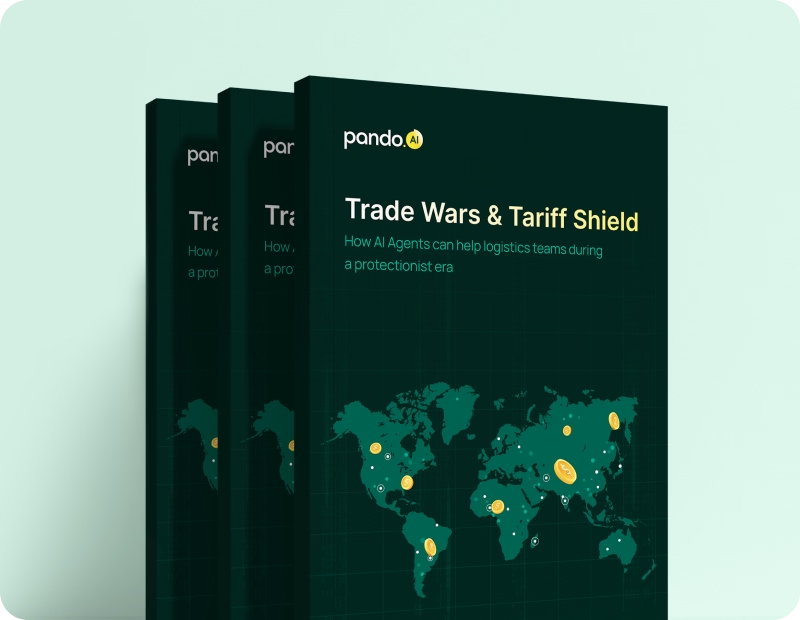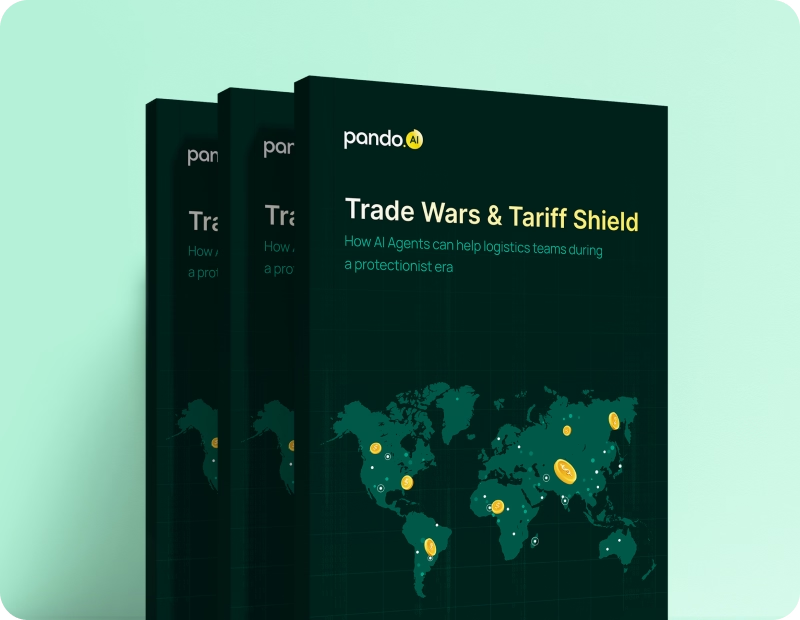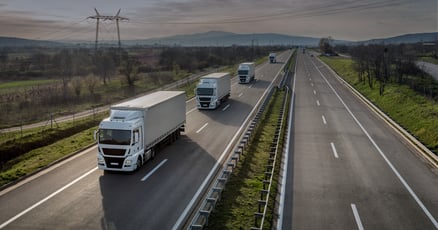-
Products Products
- Industry
- Initiatives
- Resources
- Company
- Book a demo

Before you go: Logistics leaders just dropped the truth on AI
The State of AI in Logistics 2025 is here — no hype, just real conversations and raw insights.
Greening road transport: 5 powerful strategies for eco-friendly logistics
Reduce carbon emissions and drive sustainability through smarter decisions around routes, vehicles, and loads.
Published on October 11, 2023 • 5 mins read
Durga Pratiha

Reduce carbon emissions and drive sustainability through smarter decisions around routes, vehicles, and loads.
'Green transportation’ refers to adopting methods to protect the environment while moving goods on the road. You can do this by making smart choices like using electric vehicles or biofuels instead of traditional ones, using technology to optimize routes, loads, and more. The larger aim is to lessen the harmful impact of storing, moving, and delivering goods and services on the planet. After all, embracing eco-friendly transportation practices is not just a responsibility but also an opportunity to make a real difference.
Road transport contributes significantly to greenhouse gas emissions. It accounts for about 25% of all produced emissions worldwide. This means that the choices you make about how to move goods around the world can have a significant impact on the environment. With that being said, governments around the world are hammering down on corporations to reduce GHG emissions in several ways. Here are some stats:
- As of October 2023, 68 countries and regions have implemented or announced carbon pricing mechanisms, covering over 22% of global greenhouse gas emissions.
- In 2022, the European Union launched the Carbon Border Adjustment Mechanism (CBAM), which will impose a carbon price on imports of certain goods from countries with less stringent climate policies.
As a result of these government policies and other factors, sustainability has become a top priority for many corporations. A 2022 survey by McKinsey found that 95% of CEOs believe that sustainability is important to their company's long-term success. The Apple "Mother Earth" ad is a good example of how corporations are using marketing to communicate their sustainability commitments.
In this blog, we’ll outline five actionable strategies that can help you revolutionize the way your goods are transported via road.
1. Technology for route optimization
Route optimization is a crucial feature typically found in Transport Management Systems (TMS). It is a great way to take charge of your organization’s ecological footprint by reducing fuel consumption, minimizing emissions, and improving overall efficiency. There are multiple technology tools in the market today that can help you achieve this. Here are a few capabilities these tools should have and how they can help:
-
Leverage telematics and GPS tracking to understand the routes currently being used, monitor movements across routes, and use that information to optimize your green transport operations.
-
Gain access to real-time data, traffic information, and weather conditions to ensure your vehicles are taking the most efficient routes for delivery.
-
Facilitate collaboration with other organizations to share resources.
-
TMS tools can optimize return trips and maximize vehicle load to minimize empty miles, reducing fuel consumption and emissions.
2. Incorporating eco-friendly vehicles
Consider transitioning to eco-friendly transportation and fuel-efficient vehicles. They can significantly reduce carbon footprint and contribute to environmental preservation. Opting for these eco-friendly vehicles allows you to produce fewer greenhouse gas emissions, making them a responsible choice. Electric and hybrid vehicles offer a multitude of benefits that extend beyond ecological concerns:
- Open doors to markets favoring eco-friendly options, expanding customer bases and revenue horizons.
- Yield long-term savings, despite higher initial costs, through reduced operational and maintenance expenses, allowing you to channel resources toward green initiatives.
- Reduce noise pollution and improve urban operations by mitigating noise-related rules and regulations.
3. Optimizing vehicle loads and truck mix
Effectively managing vehicle loads and selecting the right transportation solutions for each truck is crucial for organizations aiming to drive sustainability and greener road freight movement. It entails maximizing the use of available cargo space while minimizing empty space, which can result in a range of environmental and economic benefits. Here are several ways in which optimizing vehicle loads and truck mix can help organizations:
-
Reduce the number of trips required to transport your goods from Point A to Point B. This reduces fuel consumption and, so, greenhouse gas emissions.
-
Reduce the cost per unit of transported goods and gain significant cost savings for your organization, making your logistics operations more efficient and financially sustainable.
-
Ensure that your vehicles are within safe weight limits, reducing the risk of accidents caused by overloading.
-
Use accurate data on cargo volume and weights to plan routes that minimize travel distances and maximize efficiency.
4. Fostering sustainable partnerships
Promoting sustainable collaborations within your road transport logistics is a strategic approach that aligns with your organization's ethical and environmental responsibility. Fostering sustainable partnerships involves working closely with road carriers, suppliers, vendors, and other stakeholders who share a commitment to sustainable practices. Here's a detailed description of how these partnerships can boost supply chain efficiency:
-
Collaborate with road carriers who prioritize eco-friendly transportation and environmental responsibility in your supply chain.
-
Establish partnerships to foster clear and efficient communication between your organization and road carriers.
-
Work closely with road carriers who share sustainability objectives.
-
Promote the exchange of information on road carriers, their production processes, and the environmental impacts of eco-friendly transportation, facilitating better decision-making for sustainable road transport.
5. Monitoring and measuring performance
The practice of monitoring and measuring performance within an organization takes on a critical role in aligning supply chain operations with environmentally responsible and socially conscious principles. It involves setting up clear sustainability goals, selecting pertinent performance indicators, and consistently evaluating the eco-friendly and ethical performance of your supply chain. Here's how this process can be framed through a sustainability lens:
-
Define your sustainability goals: What environmental and social impacts do you want to address? Create specific Key Performance Indicators (KPIs) to track your progress, covering areas like carbon emissions, waste reduction, fair labor practices, and sustainable sourcing.
-
Collect more data: The more data you collect, the better understanding you will have of your supply chain performance. However, it is important to collect data in a way that is efficient and cost-effective.
-
Analyze collected data to find trends and areas for improvement: Use this analysis to inform decisions that enhance sustainability. For example, pinpoint opportunities to reduce resource consumption or transition to renewable energy sources.
-
Act on your findings: Modify supply chain processes to reduce carbon footprint, revise procurement policies to favor sustainable suppliers, and opt for eco-friendly packaging materials.
-
Share sustainability progress with all supply chain stakeholders: Maintain transparency and engage stakeholders in discussions and initiatives aligned with sustainability goals. Collaborate on eco-conscious projects and ethical practices throughout the supply chain.
Cultivate a greener future and foster sustainable logistics, via optimized road strategies
Embracing the above five strategies to drive sustainability in your road freight transport is not just a practical approach but a crucial step toward fostering environmentally friendly transport operations. By meticulously considering routes, vehicles, and loads, we can significantly reduce emissions and contribute to a more sustainable future. Logistic companies are now setting sustainability goals, with the adoption of eco-friendly packaging, paperless supply chain operations, and embracing environmentally friendly transport.
Such efforts not only reduce the ecological footprint of logistic operations but also enhance efficiency and cost-effectiveness. Moreover, they contribute to a more resilient and responsible supply chain ecosystem, ensuring that we meet the needs of the present without compromising the ability of future generations to meet their own.
Subscribe to Pando blog and Crossroads newsletter now!
Stay up to date with the latest logistics, transportation, and supply chain tips and news.
Subscribe Here!













